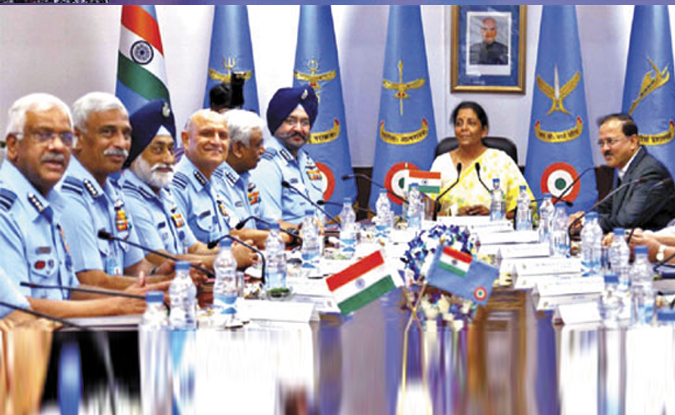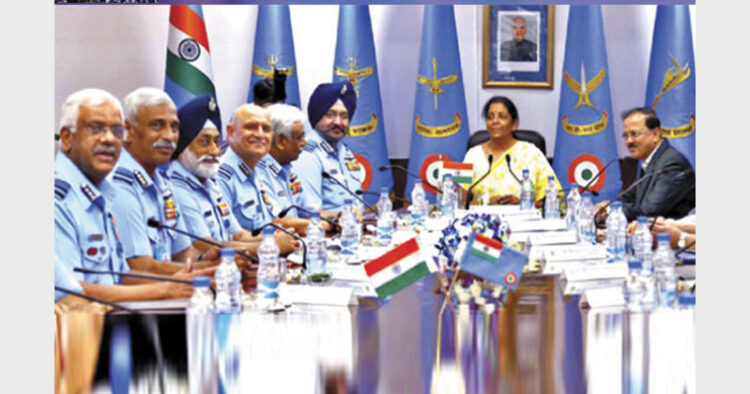Unnecessary controversy on the Rafael Deal and its politicisation by the adversaries of the Modi Government is underscoring the fact that modernisation of the Indian Air Force is a top priority

Hon’ble Raksha Mantri at the 1st biannual IAF Commanders’ Conference of 2018(AFCC18) at AHQ (VB)
Instead of conflicting narratives, hyperbole, distractions and disruptions, it is more important than ever before to identify what’s truly important right now and develop a more accurate view of the future of IAF modernisation plans to include: force levels in short, mid and long-term context and the mix of fighters to deter and dissuade adversaries from misadventures. Are 50 plus squadrons adequate by 2030, and if not what should their numbers and what mix? What will be their costs and phasing?
In the past, the Defense Parliamentary Standing Committee recommended squadron strength to be increased from the sanctioned strength of 39.5 to 42. With 18-20 aircraft per squadron, the total requirement in numbers is between 756 to 840 fighters.
If the force level is determined at 50 plus squadrons by 2030, the numbers required would be over 900 to 1000. If so what should be the mix – Gen 5 Stealth fighters; Super Su-30MKIs, Su-30 MKIs, Tejas, Rafale’s, upgraded MiG 29s, upgraded Mirage 2000s, upgraded Jaguars besides UACVs, and various types of missiles.
Politicising the National Interest
The ‘ruckus’ over the Rafale fighter deal in the Parliament by opposition parties clouds the realities of the Indian Air Force (IAF) fighters modernisation plans and programs particularly its force level based on 50 plus squadrons by 2050.
Furthermore, the fury and the cacophony indulged by the Troika – Yashwant Sinha, Arun Shourie and Prashant Bhushan – in the media further obfuscates key issues of IAF modernisation. As intellectuals having access to sources inside the closed doors, they should have brought the shortcomings of IAS modernisation into the limelight and done justice to national security, particularly since two of them had held Cabinet berths in the past instead of indulging in “politics of paralysis” – a disservice to the nation.
Even after nearly 60 years in the field, HAL and DRDO-Gas Turbine Research Establishment (GTRE) are way behind technologically to produce advanced engines due to lack of requisite metallurgical abilities and infrastructure
The IAF must project their estimated projections annually at the time of Air Force Commanders Conference, which must be attended by the Prime Minister, Members of Cabinet Committee of Security, Members of the Defense Planning Committee, and with the Heads of Hindustan Aeronautics Limited (HAL), Defense Research and Development Organization (DRDO) in attendance.
Based on current adversaries technological capabilities and estimated breakthroughs, should the suggested mix of force levels by 2030 be determined to include: Generation 6 hypersonic fighter squadrons; 10 x Generation 5/5 Plus squadrons; 30 x Generation 4 Plus squadrons; and 10 x ground attack squadrons! Also, Radars, EW suite, estimates of Generation 6 missiles of all types, Unarmed Aerial Combat Vehicles and allied infrastructure requirements must be projected.
Importantly, life-cycle costs – womb to tomb – consideration is critical to select the right mix of fighters and their numbers to meet operational requirements. As per data available in the public domain, the unit cost of Su 30 MKI in 2013 was only Rs.358 crores. And, the Tejas Mk 1A is Rs.463 crore (US$67 million); but the budget allocation of Rs.50,025 crores for the production of 83 Tejas Mk-1A, would mean unit cost of over Rs. 600 crores. In contrast, the unit cost of Rafale is approx Rs.670 crores.
To respond to China’s Su-35 and J-31 stealth fighters, is the plan to upgrade the first 80 Su-30MKIs to the level ‘Super Sukhois’ which involves equipping the aircraft with long-range stand-off missiles up to the range of 300 km and to integrate Brahmos supersonic cruise missile adequate? The possible upgrades to the MKI are adding a more effective Multi-role, like Multiple ejector Rack, AESA radar, more powerful EW and Jamming systems, along with High-performance Engines. Most importantly, as per media reports, Russia has offered Super Su 30MKI at half the cost of Rafale. What about the stealth capabilities?
Let me highlight that modern jet fighters are highly complex-cum-superior technological combat system incorporating and integrating various high-tech systems to include: advanced air-frame with 6000 flying hrs; chassis wheels braking system; uprated supercruise engines with 5th gen capabilities; AESA Radars tracking 30 aerial targets at a time and electronic warfare systems. It also includes Fly by wire (FBW) with quadruple redundancy; advanced head-up display along with bi-cubic phase conjugated holographic displays and Seven liquid crystal multi-function displays. Modern digital weapons control system as well as more advanced anti-jamming features; advanced targeting pods; and a variety of weapons capability – air-to-air short and Beyond Visual Range missiles, air to ground missiles and close combat capabilities and so on.
Today, even after nearly 60 years in the field, Hindustan Aeronautics Limited (HAL) and Defense Research Development Organisation (DRDO)-Gas Turbine Research Establishment (GTRE) are way behind technologically to produce advanced engines due to lack of requisite metallurgical abilities and infrastructure.
Thus, the MPs, media and defence experts must focus on debating such key issues concerning projected force levels, a mix of fighters, life-cycle costs analysis, phase-wise annual increments and budgeting to participate in debates constructively and creatively instead of ‘paralysing’ decision making by just making lots of noise thereby compounding the confusion.
For example, engines constitute the important component of fighters. The HAL Chief and the DRDO must confirm the assessed requirement of engines as of now in the pipeline to include: 100 F-404 engines for the Tejas Mark I, another 100 F-414 engines for the Tejas Mark II; and 400 F-414 Enhanced Engines for next-generation fighters. Since an aero engine’s life is about 1,500 hours, each fighter – with a service life of 5,000-6,000 hours – consumes 3.5 engines. How many out of 700 engines would be supplied by the GE and indigenously manufactured for the Tejas Marks I and II, and 1,400 engines for the next generation fighters. As per the DRDO estimates the value of engines requirement is Rs 3, 50,000 crores over the coming decade. Surely, the engine development and costs deserve informed debate!
Air Marshal (Retd) Anil Chopra’s article of 2017 provides a professional’s “Birds Eye View” of aircraft jet engine development in India HAL Engine Division, Bangalore set up in 1957 and the DRDO’s GTRE in Bangalore, set up in 1959 – almost 60 years ago. He has traced the evolution fighter after World War II to include: gas turbine engines, turbojet, afterburner engines for supersonic aircraft, and the supercruise capability without the use of afterburner engines.
A Much Needed Future
It may be noted that super-cruise enables F-22 Raptor, Rafael, Euro fighter Typhoon, and F-35 to accelerate to supersonic speed without using augmentation and then sustain such a speed indefinitely in dry thrust. Also, super-cruise also reduces the IR (infrared) signature by some 75%, thus making aircraft safer from heat-homing Air to Air Missiles.
Next, Russians were the first to research vectored thrust engines and also Bristol Siddeley introduced unique nozzles for the Harrier V/STOL aircraft. The high manoeuvrability of the Su-27 and the subsequent fighters from the Sukhoi stable extensively use thrust vectoring for the aerodynamics-defying high agility. Euro fighter’s EJ200 engine is also likely to opt for thrust vectoring during the first mid-life update.
Let me also highlight that the aircraft jet engine development remains a domain of the few to include: Pratt & Whitney (USA), General Electric (USA), Rolls-Royce (UK), Tumansky (Russia), Lyulka/Saturn (Russia), Euro Jet (UK, Germany, Italy, Spain) and SNECMA (France; Mirage-2000, Rafael). Others nations, such as China, have been trying to develop engines based on designs of existing Aircraft engines. HAL and DRDO-GTRE are way behind either in innovation or in ‘reverse engineering’.
In retrospect, both the HAL and the DRDO-GTRE state-owned behemoths have failed to develop and deliver high-tech engines for LCA Tejas even after nearly 29 years of project launch. And, they indulge in blame games to cover up their shortcomings and failures. Perhaps, innovation is anathema to them. Perhaps, there is a need to rename the GTRE as Ramjet or Vector Thrust Research Establishment.
My appeal is simple – stop playing politics and stalling modernisations. Let there be greater transparency and informed and constructive debate both inside the Parliament and in open forums. Let not the taxpayers and the common people are fooled for eternity under the secrecy clause when design and developments of futuristic technologies are available in the public domain.
(The writer is a security and strategy analyst)













Comments